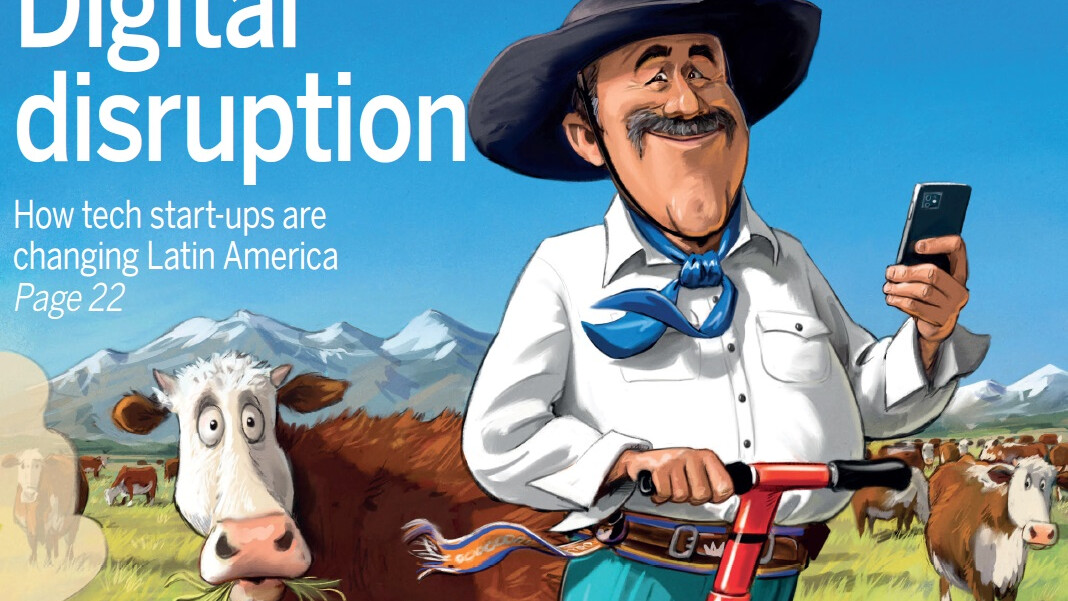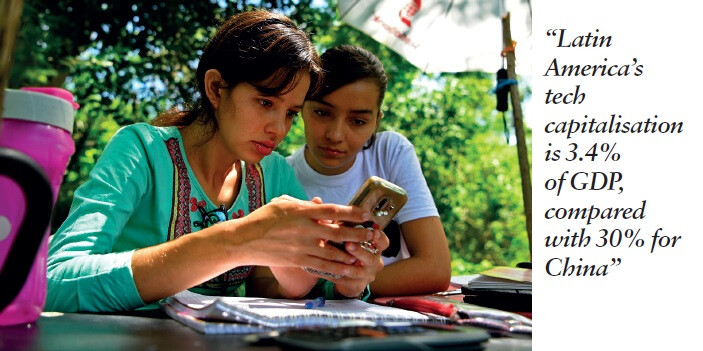Latin America's Digital Revolution
Covid-19 battered Latin America, killing more people and causing deeper recessions than anywhere else. But the disruption bred solutions to regional challenges, accelerating a tech boom...

Covid-19 battered Latin America. It killed more people and caused deeper recessions than in any other region. But the massive disruption forced people to solve centuries-old regional challenges, accelerating a nascent digital revolution that will eventually save more lives and drive more economic growth than was lost in the pandemic. The region’s tech boom will also create a lot of wealth for investors.
Latin America only saw its first unicorn - the name given to private tech start-ups worth more than $1billion – in 2017. Now those mythical beasts are a lot less rare, with 34 in the region today. Latin America attracted more tech funding than similar-sized South East Asia last year and almost the same amount as much-larger India. Venture capitalists are pouring billions into the region’s start-up companies, while a wave of Latin American tech listings in the US means that retail investors can also play the story.
Latin American Tech
For a long-time Latin America was an ‘innovation desert’. A barren, bureaucratic, venture capital-starved landscape with few successful tech start-ups. Most international investors focused on the region’s incredible commodity resources and assumed that Latin America’s poor education, weak internet coverage and excessive bureaucracy would make tech innovation impossible.
In fact, the opposite is true. The terrible quality of local services makes the region a fertile ground for Latin American tech start-ups with good solutions. The local banks, which are amongst the most profitable in the world, are very expensive and offer limited services. Public transport consists of a few fume-emitting second-hand busses. Please don’t take this as a criticism of Ecuador – I love the place – but it helps explain why apps that offer people better mobility, banking, health and education services will do well.
And Ecuador is typical of the region. World Economic Forum analysis shows that Latin America has the worst quality infrastructure anywhere in the world outside of sub-Saharan Africa. Public education is shocking, with 50% of 15-year-olds unable to read properly. And, even before the pandemic, health systems in various Latin American countries were at the point of collapse. As for the financial system, a World Bank study showed that nearly half of the region’s entire population was unbanked before the pandemic.
But being a bundle of needs isn’t enough on its own to foster tech innovation. Latin America also had several positive factors in its favour. Demographics play a crucial role in Latin America’s tech boom. The region’s middle class expanded to 46 million households from 33 million between 2008 and 2018 and is increasingly moving to cities. Latin America is the world’s most urbanised region: 260 million people – approximately 40% of the total population – currently live in Latin America’s 200 largest cities and generate 60% of the region’s GDP.
Internet usage in Latin America has exploded, reaching 450 million people in 2019 from just 200 million in 2010, making it the world’s fastest-growing internet population. Not only do Latin Americans have access to the internet – they’re taking full advantage of it. The region’s social media use is higher than any other region in the world, and almost double the North American average. The rising purchasing power of Latin Americans, coupled with increasingly widespread internet access, makes them more willing to purchase products and services through new tech platforms.
But a lack of venture capital meant Latin America was slow to find tech solutions to its long-standing problems. The region is dominated by family-owned firms, whose main aim is to preserve capital in a volatile political environment, not back exciting tech ventures. That gradually started to change with analysts at the Latin American Venture Capital Association estimating that venture investment into the region doubled every year from 2016 to 2019. Then in 2019, Softbank announced a $5billion Latin America-focused tech fund. That helped Latin America attract $4billion of VC tech funding in 2020 – more than South East Asia. Meanwhile a host of Latin American tech companies listed on US tech-focused exchange, the Nasdaq, providing another way for the sector to attract international capital.
Pandemic impact
All of those developments were positive but the pandemic was the gamechanger. In 2021, venture-backed companies raised $14.8billion across 772 deals in Latin America, according to PitchBook data. That's more than the total tech capital invested in the region over the previous six years.
A lot of the focus is on fintech, which makes sense when you consider that Latin American banks have higher profit margins than anywhere else on earth. Yet around 60% of the venture capital raised last year was for non-fintech companies. That’s because the pandemic created a massive increase in demand for health, ecommerce, mobility and education services in Latin America. The region implemented some of the world’s longest and severe lockdowns and these restrictions pushed people into finding tech solutions.
Nicolás Szekasy, co-founder of Kaszek Ventures, one of Latin America’s largest venture capital firms, tells the Financial Times. “When you look at the metrics for ecommerce penetration, what was achieved in the last 18 months probably would have taken several years organically.” Stats from Mastercard capture the pandemic’s impact on tech. The need to avoid cash and make digital payments pushed 40 million Latin Americans to open a bank account for the first time between May and September 2020.
Education was another area ravaged by the pandemic. Many state school children in Ecuador have not had an in-person lesson since March 2020. That colossal policy error is repeated across the region, which inflicted longer school closures on children than any other region. “Nowhere else in the world so many children are currently left without face-to-face schooling,” says Jean Gough, UNICEF Regional Director for Latin America and the Caribbean. “This is the worst education crisis Latin America and the Caribbean has ever faced in its modern history.” Even when schools do reopen – in Ecuador the holidays mean that will not be until May 2022 – there will be a massive education deficit to make up for. And Latin America’s edtech companies can help.

The region’s failing health systems are another obvious target for tech solutions. Barring some positive outliers – such as Costa Rica, Uruguay and Cuba – the region’s health systems are inefficient and underfunded. The Latin American average for health spending is less than 4% of GDP compared to 8% in Europe. Health tech can help in two ways. The first is that historically weak states mean that Latin American public services rarely reach remote rural areas. Technology offers a way for competent doctors to virtually attend patients in isolated communities. The second is that by bringing down costs, technology allows poorer Latin Americans to receive a health service that isn’t available in the public system and is too expensive in traditional private hospitals. A great example is Dr. Consulta, a venture capital-backed network of low-cost clinics, which is now the biggest private medical service provider in Brazil. It started out as a bricks and mortar clinic in a favela in 2011 but now complements its physical locations with a digital practice that boomed during the pandemic.
Risks
Of course, there are some risks worth highlighting. Politics for a start. Latin America’s coups and caudillos have always captured the imagination and with Venezuela, Nicaragua and Bolivia we still have plenty of present-day examples. But in the last twenty years democracy has strengthened across most of Latin America. Alfredo Mordezki, Head of LatAm Fixed Income at Santander Asset Management, believes investors are unduly hard on region. “Being a LatAm-focused investor for more than 20 years, I am often reminded by clients of the political volatility in the continent, which makes the region less attractive to investments compared to Asia, and specifically, to China. The latest crackdown on Chinese private education companies and the wiping out of $70billion of market cap from Jack Ma’s companies, should make investors think about the difference between stability and the rule of law. Institutions are hard to build, it takes a long time to make them resilient to tyrants and history shows that even the US may show some cracks over time. The landscape has become globally a lot more uncertain, but still democracies, even weak ones, have in place institutions that make arbitrary decisions harder to implement.”
Indeed, Latin American governments may actually help tech investors. That’s because the pandemic has forced many bureaucrats in the region to update antiquated processes, which typically involved queuing up to get documents stamped, that were impractical during the pandemic. Carlos Urriola, the CEO of a large local port, Manzanillo International Terminal, explains how Covid-19 has forced the government to streamline paperwork. “The government has digitalised processes at a much faster rate than its predecessors because it was forced to by the pandemic.”
Rising interest rates are the biggest threat to these tech companies. The appeal of buying into tech firms that dangle the carrot of big earnings ten years down the line, dwindles when interest rates rise and risk-free assets like US Treasuries start offering higher yields right now. Some of that has already played out in the market. Mercado Libre is down 50% since its 2021 high, while many of the recently-listed Latin American tech companies have fallen below their debut IPO price.
But good companies with solid earning potential will do well over the next decade regardless of current market jitters. For example, Mercado Libre survived the dot.com bust to become Latin America’s most valuable company. Indeed, the fact that tech firms are currently out of favour makes this a good time to buy into a great long-term story. Julio Vasconcellos, co-founder of Atlantico, a Latin American venture capital fund, makes a very good case for this in the FT. He notes that Latin America’s total tech market capitalisation stands at 3.4% of GDP, compared with 30% in China and 14% in India. If Latin America were to get to China’s level, then “we’re talking about the equivalent of over a trillion dollars of market value being created”. Investors should look for the best ways to play the trillion-dollar investment opportunity.
A version of this article was first published in MoneyWeek on the 11th of February.